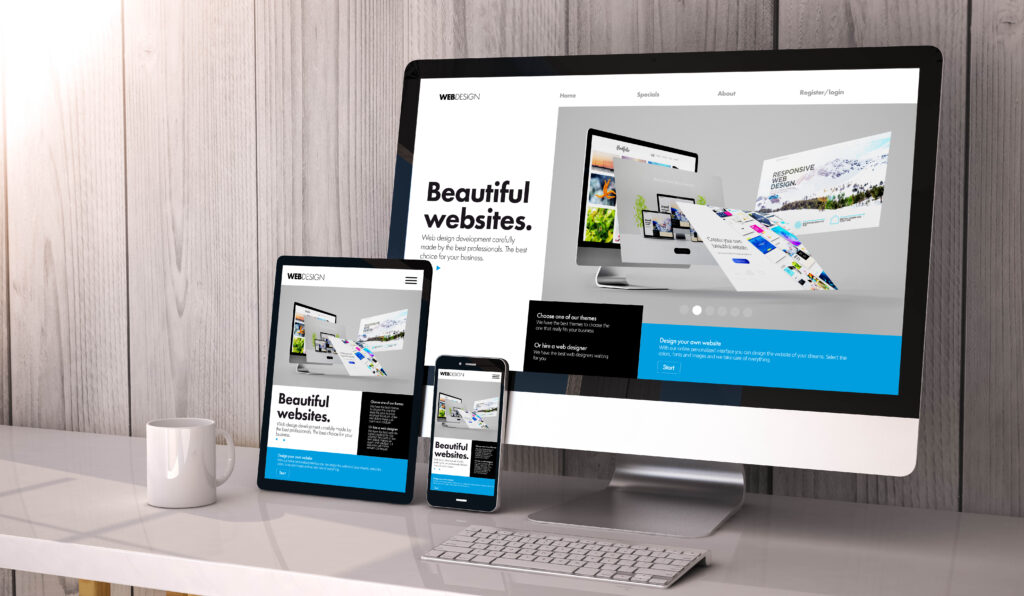Introduction to Website Builders
In today’s digital era, a professional online presence is imperative for any business or personal brand. A Website Builder is a vital tool for achieving this, providing a platform where you can create a website without the need for coding skills. These tools have democratised the process of website creation, making it accessible to everyone regardless of technical proficiency.
Website Builders come with a range of features designed to streamline the design and publishing process. They typically include drag-and-drop editors, which allow you to place elements like text, images, and videos onto your webpage effortlessly. This user-friendly interface is one of the primary reasons why website builders are so popular among small business owners and individuals alike.
Another key advantage of using a Website Builder is the array of pre-designed templates and themes available. These templates offer a starting point for your design, which you can customise to match your brand’s identity. The variety of options ensures that you can find a template that aligns with the aesthetic and functional requirements of your website.
In addition to templates, Website Builders often provide customisation options that allow you to personalise your site further. You can adjust colours, fonts, and layout settings to create a unique look that represents your brand accurately. This level of customisation ensures that your website does not look generic but stands out in a crowded online space.
One of the most significant benefits of using a Website Builder is the inclusion of essential services such as web hosting and domain registration. These services are often bundled into the cost of the website builder, simplifying the process of getting your site online. This all-in-one solution is particularly beneficial for those who may find the technical aspects of web hosting and domain management daunting.
Moreover, Website Builders usually come with integrated SEO tools that help optimise your site for search engines. These tools can guide you in selecting appropriate keywords, creating meta tags, and generating sitemaps, all of which are crucial for improving your site’s visibility in search engine results. Some builders even offer analytics tools, allowing you to track your site’s performance and make data-driven decisions to enhance its effectiveness.
Security is another important aspect where Website Builders excel. They typically offer SSL certificates and other security measures to protect your site and its visitors. This is particularly important if your website involves e-commerce or collects sensitive information from users.
Customer support is another feature that makes website builders an attractive option. Most platforms offer various forms of assistance, including tutorials, FAQs, and direct customer service. This support can be invaluable, especially for those new to website creation, providing guidance and troubleshooting when needed.
In summary, a website builder is a comprehensive tool that simplifies the process of creating a professional, functional, and visually appealing website. With features designed to cater to both beginners and more experienced users, these platforms offer a practical solution for anyone looking to establish an online presence.
Selecting the Ideal Website Builder
When it comes to choosing the right Website Builder, several factors should guide your decision. The cost is a significant consideration, as website builders usually range from £10 to £50 monthly and include web hosting and domain registration. Ease of use, the availability of templates, customisation options, and customer support are other crucial elements to evaluate. Comparing popular Website Builders such as Wix, Squarespace, and Weebly can help you determine which one aligns best with your goals.
Ease of use is one of the most critical aspects to consider. Some platforms offer intuitive drag-and-drop interfaces, which make it simple to add elements like text, images, and videos to your website. Others might provide more advanced options, requiring a steeper learning curve but offering greater customisation. Assessing your comfort level with these tools can save you time and frustration in the long run.
Another important factor is the range of templates and themes available. These pre-designed options can significantly speed up the design process. Look for website builders that offer a variety of templates tailored to different industries and purposes. This variety will allow you to choose a design that closely matches your brand’s identity, reducing the amount of customisation needed.
Customisation options are equally important. Even the most beautifully designed template might need tweaking to suit your brand perfectly. Check if the website builder allows you to modify colours, fonts, and layouts. Some platforms offer advanced customisation options, including access to the site’s CSS, which can be invaluable for creating a unique look.
Customer support can make a big difference, especially if you encounter issues during the website creation process. Many website builders offer various forms of assistance, including live chat, email support, and extensive knowledge bases. Knowing that help is readily available can provide peace of mind and ensure a smoother building experience.
In addition to these features, consider the scalability of the Website Builder. As your business grows, your website needs might change. Look for platforms that offer scalable solutions, such as additional storage, bandwidth, and advanced features like e-commerce capabilities. This flexibility will allow your website to grow alongside your business without requiring a complete overhaul.
Finally, it’s essential to consider the integration options offered by the Website Builder. Integration with third-party tools and services, such as social media platforms, email marketing software, and analytics tools, can enhance the functionality of your website. These integrations can streamline your workflow and provide valuable insights into your website’s performance.
Comparing popular Website Builders like Wix, Squarespace, and Weebly can help you identify the platform that best meets your needs. Each has its strengths and weaknesses, so taking the time to evaluate them against your specific requirements is crucial. Remember to read reviews and take advantage of free trials or demos to get a hands-on feel for the platform before making a decision.
Preparing Your Website Plan
Before diving into the website building process, laying out a clear and strategic plan is essential. Begin by defining the primary objectives of your website. Are you looking to generate leads, sell products, provide information, or showcase a portfolio? Clearly outlining your goals will guide the overall structure and functionality of your site.
Next, identify your target audience. Understanding who will visit your site is crucial for tailoring both its design and content. Consider the demographics, interests, and behaviours of your potential visitors. This information will help you craft a user experience that resonates with your audience and meets their needs effectively.
With your objectives and audience in mind, sketch out a basic layout and structure for your website. This includes determining the main pages you will need, such as Home, About, Services, Blog, and Contact. Think about how these pages will link together and what the user journey will look like. This planning phase is crucial for creating a website that is easy to navigate and provides a seamless user experience.
Once you have a rough structure, delve into the specifics of your content. Start by brainstorming the type of content that will populate each page. For example, the Home page might include a brief introduction to your business, key services, and testimonials. The About page could provide background information about your company and team. Planning your content in advance ensures that each page serves a clear purpose and provides value to your visitors.
While content is king, visuals play a significant role in engaging users. Plan the types of images, videos, and other multimedia elements you will include on your site. High-quality visuals not only enhance the aesthetic appeal of your website but also help convey your message more effectively.
Don’t overlook the technical aspects of your website plan. Consider the functionalities you might need, such as contact forms, booking systems, or e-commerce capabilities. Listing these requirements in advance will help you choose the right website builder and ensure that your site meets all your operational needs.
Additionally, think about how you will organise and categorise your content. A well-organised website with clear categories and tags makes it easier for users to find the information they are looking for. This also aids in better search engine optimisation, as it allows search engines to crawl and index your site more efficiently.
Finally, establish a timeline for your website project. Set realistic deadlines for each phase of the building process, from initial planning and content creation to design and launch. Having a timeline keeps you on track and ensures that your project progresses smoothly without unnecessary delays.
By thoroughly preparing your website plan, you lay a strong foundation for a successful online presence, making the actual building process more streamlined and effective.
Designing Using a Website Builder
Website builders offer a range of templates and themes that give your site a professional appearance. For example, “Squarespace features a lot of great templates”, which can be customised to match your brand’s identity. Adjusting design elements like colours, fonts, and images will help to create a unique look that reflects your brand. With these tools, you can ensure that your website not only looks good but also serves your business’s functional needs effectively.
One of the first steps in the design process is selecting a template that aligns with your brand and business objectives. Website builders typically offer a wide range of templates tailored to various industries, which can significantly speed up the design process. Once you’ve chosen a template, you can customise it to fit your brand’s colour scheme, fonts, and layout preferences.
Drag-and-drop editors are a standout feature of many website builders, allowing you to effortlessly add and arrange elements on your page. This intuitive interface enables you to include text, images, videos, and other multimedia components without needing any coding knowledge. As a result, you can focus on crafting a visually appealing and functional site that meets your specific needs.
In addition to basic design adjustments, some Website Builders offer more advanced customisation options. For instance, you might have access to the site’s CSS, allowing you to make precise changes to the design elements. This can be particularly useful if you have specific branding guidelines or a unique vision for your site.
Incorporating multimedia elements like images and videos is crucial for engaging visitors and conveying your message effectively. High-quality visuals can enhance the overall aesthetic of your website and help communicate your brand’s story. Many Website Builders include image libraries and video integration options, making it easy to add these elements to your site.
Another essential aspect of website design is ensuring your site is mobile-responsive. With a significant portion of internet traffic coming from mobile devices, it’s crucial that your website looks and functions well on smartphones and tablets. Most website builders automatically optimise your site for mobile viewing, but it’s always a good idea to preview and test your site on various devices to ensure a seamless user experience.
Finally, consider the user experience when designing your website. A well-organised layout with clear navigation menus can significantly enhance usability. Think about the user journey and how visitors will interact with your site. Easy-to-find information and a logical flow will keep users engaged and encourage them to explore your content further.
Incorporating Content into Your Website
Content is the heart of your website, serving as the primary means of communicating your brand’s message and value proposition to your audience. Start by identifying the key types of content that will populate your site, such as text, images, and videos. Each type plays a distinct role in engaging visitors and conveying information effectively.
When it comes to textual content, clarity and relevance are paramount. Craft your text to be engaging and easy to understand. Break up large blocks of text with headings, subheadings, and bullet points to enhance readability. Use active voice and straightforward language to keep your audience’s attention. Consider the use of storytelling techniques to make your content more compelling and relatable.
Visual content is equally important. High-quality images can significantly enhance the aesthetic appeal of your site and help convey your brand’s message more effectively. Use relevant and professional images that resonate with your target audience. Videos are another powerful tool for engagement; they can be used for tutorials, testimonials, or product demonstrations. Ensure that all visual elements are optimised for fast loading times to prevent slowdowns that could deter visitors.
Multimedia elements should not only look good but also serve a functional purpose. For instance, infographics can simplify complex information, making it more accessible to your audience. Interactive elements, like quizzes or surveys, can engage visitors and provide valuable insights into their preferences and behaviours.
Incorporating user-generated content, such as reviews or testimonials, can add credibility to your site. These elements provide social proof, helping to build trust with potential customers. Make sure to showcase these testimonials prominently, perhaps on the home page or in a dedicated section.
Consistency in style and tone is crucial across all content types. This ensures a cohesive brand experience and makes your site more professional. Develop a content style guide that outlines your brand’s voice, tone, and visual guidelines to maintain uniformity.
Search engine optimisation (SEO) should be a key consideration when adding content. Use relevant keywords naturally within your text to improve search engine rankings. Meta descriptions, alt text for images, and keyword-rich headings can all contribute to better SEO performance. Make sure your content is shareable to encourage backlinks, which can further boost your search engine ranking.
Finally, regularly update your content to keep it fresh and relevant. This not only improves the user experience but also signals to search engines that your site is active and up-to-date. Regularly reviewing and refreshing your content ensures that it remains aligned with your business objectives and audience needs.
By carefully crafting and curating your website content, you can create a rich, engaging, and effective online presence that resonates with your audience and supports your business goals.
Launching and Maintaining Your Website
Launching your website is an exhilarating milestone, marking the moment your digital presence becomes accessible to the world. Before you hit that launch button, double-check that all the components of your site are functioning correctly. Conduct a thorough review of each page to ensure there are no broken links, missing images, or typos. This final check helps to avoid any hiccups that could detract from your site’s professional appearance.
Once you are confident that everything is in order, follow the steps provided by your Website Builder to go live. This typically involves connecting your domain name, setting up any necessary redirects, and adjusting privacy settings to ensure your site is indexed by search engines. It’s also wise to preview your site on different devices and browsers to confirm that it looks and functions as intended across all platforms.
After your website is live, the work doesn’t stop there. Regular updates and maintenance are essential for keeping your site fresh and relevant. This includes updating content, adding new features, and ensuring that all plugins and software are up to date. Regularly reviewing your site’s performance through analytics tools can provide valuable insights into visitor behaviour, helping you make data-driven decisions to improve user experience and engagement.
Another crucial aspect of website maintenance is security. Ensure that your site is protected against potential threats by implementing robust security measures. Regularly updating your website builder, plugins, and themes can prevent vulnerabilities. Many Website Builders offer automatic updates and security features such as SSL certificates to help safeguard your site and its visitors.
Backup your site regularly to protect against data loss. Many Website Builders offer automatic backup options, but it’s good practice to create manual backups periodically. This ensures that you can quickly restore your site to its previous state in case of any unforeseen issues.
Monitor your site’s loading speed and performance. Slow-loading pages can frustrate visitors and negatively impact your search engine ranking. Use performance optimisation tools to identify and resolve any issues that might be causing slowdowns. This could involve compressing images, enabling browser caching, or optimising your site’s code.
Engage with your audience by keeping your content updated and relevant. Regularly add new blog posts, update your portfolio, or refresh your service offerings. This not only keeps your audience engaged but also signals to search engines that your site is active and worth ranking.
By diligently maintaining your website, you can ensure it remains an effective and engaging platform for your business, providing a seamless experience for your visitors and supporting your ongoing growth.
Enhancing Your Website for Search Engines
Search engine optimisation (SEO) is crucial for increasing your website’s visibility and driving organic traffic. One of the first steps in enhancing your site for search engines is to conduct thorough keyword research. Identify the keywords and phrases that your target audience is likely to use when searching for products or services like yours. Incorporate these keywords naturally into your content, including titles, headings, and meta descriptions.
Optimising meta tags is another essential aspect of SEO. Meta titles and descriptions should be concise, relevant, and include your primary keywords. These elements provide search engines with a summary of your page’s content and can significantly impact your click-through rates.
Backlinks, or inbound links from other reputable websites, can also boost your SEO performance. High-quality backlinks signal to search engines that your site is trustworthy and authoritative. Consider guest posting on industry blogs, collaborating with influencers, or creating shareable content to earn valuable backlinks.
Site speed is another critical factor for SEO. Search engines prioritise fast-loading websites, so optimising your site’s performance can improve your rankings. Compress images, enable browser caching, and minimise code to enhance loading times.
Ensuring your website is mobile-friendly is vital, as a significant portion of internet users access websites via their smartphones. Responsive design automatically adjusts your site’s layout to suit different screen sizes, providing a better user experience and improving your search engine ranking.
Regularly updating your content keeps your site relevant and signals to search engines that it is active. Fresh content can include blog posts, news updates, or new service pages. An active website is more likely to be indexed frequently, enhancing its search engine performance.
Finally, utilising analytics tools can help you monitor your SEO efforts. Tools like Google Analytics and Google Search Console provide insights into your website’s traffic, user behaviour, and keyword performance. Use this data to refine your SEO strategy continually, adapting to changes in search engine algorithms and user trends.
By implementing these SEO practices, you can significantly improve your website’s visibility, attracting more visitors and achieving your business goals.



